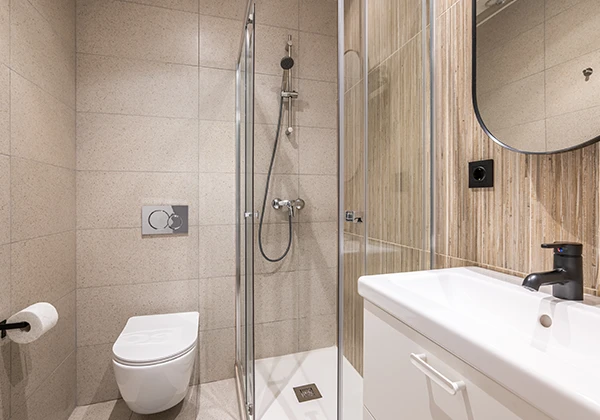Design Ideas for Small Bathrooms

Trying to cram all the amenities and features you desire into a tiny bathroom can be quite a challenge. However, with a few innovative small bathroom design ideas, there are ways to create the bathroom of your dreams within the limited space you have available. Below are a few affordable small bathroom design ideas you can apply to get the most from a tiny bathroom without feeling cramped or cluttered.
Small Bathroom Layout Ideas: The Basics
It is important to note that your small bathroom design layout must be in accordance with the state or local area’s building codes. These building codes stipulate minimum distances between certain bathroom fixtures and the surrounding walls and could impact your proposed layout.
It also pays to be aware of the following four guidelines of bathroom balance when embarking on a small bathroom remodel project.
Align All Fixtures and Fittings on One Wall
Placing the sink, toilet, and shower or bathtub along one wall creates a neat and organized appearance and frees up floor space, similar to the galley effect experienced with a long and narrow kitchen.
Place Larger Fixtures Further from the Door
Placing large fixtures like a shower enclosure or bathtub as far away from the doorway as possible creates an illusion of broader and longer space. This results in a small bathroom that doesn’t feel cramped.
Consider the Fixtures You Need and Eliminate the Ones You Don’t
When space is at a premium, it is important to consider which fixtures are necessary. Installing a shower rather than a bathtub can open up some floor space, and using smaller fixtures where possible will allow for a balanced design.
Maintain a Clear Line of Sight
Incorporating a frameless and clear shower enclosure can give the bathroom an airier appearance since your gaze can travel all the way to the back of the space.
Now let’s look at a few innovative small bathroom remodel ideas on a budget.
Incorporate Mirrors Along the Walls
A mirror along one wall can create the illusion of double the space and is extremely effective when working with a narrow room. Try incorporating a mirror above a vanity or along one side of the bathroom. This will also reflect the available light, amplifying the illumination from the windows and light fixtures.
Use Wall-Mounted Toilets
Wall-mounted toilets with a tank built into a wall can save a great deal of floor space and open some much-needed legroom in a smaller bathroom. Suppose the available space within the wall isn’t enough to accommodate the tank. In that case, you could try incorporating a shelf above the toilet tank or extend the top of the vanity to create a ledge to provide a bit of extra storage space.
Consider Eliminating the Tub
A bathtub can take up twice as much floor space as a compact shower, and getting rid of it can give you a lot more room. If you absolutely need a bathtub, consider fitting one with a lower profile. This will not only allow for easier ingress and egress but also make your bathroom seem more spacious and roomy.
Incorporate Frameless Shower Panels
Replacing shower curtains with frameless glass panels can open up the bathroom visually and also let more light in. Glass panels are also extremely easy to install, maintain, and keep clean. Pick fixed or hinged panels rather than sliding ones, as the tracks required for sliding panels can add clutter and are harder to clean.
Use Curbless Showers and Continual Flooring
Curbless showers are a fantastic idea for a modern small bathroom remodeling ideas layout. The curbless shower design allows the flooring to continue uninterrupted into the shower and can be combined with an infinity-edge or concealed drain for an extremely streamlined look. This design works well with concrete, tiled, or stone slab floors and is also very easy to clean.
Save Space With Small Sinks and Floating Vanities
Wall-mounted sinks can open up a great deal of floor space, just as wall-mounted toilets do. Consider using a wall-mounted vanity to cover your storage needs and a narrow, thin-edge sink to make the best possible use of the available space in your bathroom.
Use the Walls To Mount Cabinets and Open Shelves
While floor space may be at a premium in a small bathroom, installing shelves on the wall and above the toilet and recessed cabinets with mirrors can be great ways to boost storage. Fit narrow shelves or metal towel racks along the wall above the toilet or at the end of the tub to maintain a clean look, and don’t forget to incorporate robe hooks behind the door.
Save Space With Pocket Doors
Switching out your in-swinging bathroom door for a pocket door can create up to nine square feet of usable space within your bathroom. A pocket door can be installed by opening up the wall to create a pocket for the door to slide into, and this arrangement can provide a great deal of flexibility when it comes to positioning your fixtures and fittings. A surface-mounted sliding door can also provide similar benefits while creating a barn door effect.
Combine Dark Floors With Light-Colored Walls
Bright or light-colored walls can make a small space look larger than it is by virtue of reflecting a large amount of light, while dark walls can make the space look even smaller. If you must use darker shades, reserve these for the floor, and maintain a light color scheme for the walls to maintain an airy look and feel. Using tiles that match the color and tone of wooden bathroom floors can also create the appearance of a continuous floor, giving the impression of a larger space.
Add an Accent Wall
An accent wall is an excellent way to add some color to your small bathroom. The back wall is an ideal location to place the accent wall, and it will give the bathroom a bit of depth in addition to livening up the space with a dash of color. Consider using fun, striking colors and patterns for your accent wall, and contrast them against lighter shades on the rest of the walls for the best effect.
Small Bathroom Layout Ideas: Organized by Shape
The ideal small bathroom design layout for your bathroom will depend on the shape of the room. Below are a few design suggestions for the most common bathroom shapes.
Small Rectangular Bathrooms
If you have a narrow, rectangular bathroom with the door on a shorter side, you should aim to position all fixtures and fittings along one side. This helps create the illusion of an elongated space and simplifies the plumbing installation.
On the other hand, if your bathroom is short and wide with the door located along one of the longer sides, you might want to locate the shower along one of the shorter walls or consider a bathtub if you can incorporate one without making the space feel too cramped. The sink can be placed across from the door, with the toilet located to the side. If the room offers enough depth, you might be able to place the sink and toilet along the wall across from the shower, further opening up some space in the center of the bathroom.
Small L-Shaped Bathrooms
Locating the shower along the shortest side or in the corner works best with an L-shaped bathroom, with the toilet and sink side-by-side along the longer wall. Sliding shower doors work best here, or you could opt for a short-swing glass door for the corner shower.
Small Square Bathrooms
The layout you choose for a small square bathroom will depend greatly on where the door is located. The door placed in the center of one of the walls will make it nearly impossible to accommodate a bathtub, and you will be better off considering a corner shower instead. With the door located off to one side, closer to one of the corners, you will probably have enough space to squeeze a bathtub in, but you may have to consider a pedestal sink rather than a large vanity.
Summary
A leader in the home improvement space,RemodelYourHome has over 20 years of experience connecting homeowners with relevant construction experts and contractors based on their specific requirements. Get in touch to connect with bathroom remodeling professionals in your local area who can help guide you through your small bathroom remodeling service and make the best possible use of the space you have available.

Remodel Your Home
We are a leader in the home improvement space with over 20 years of experience pairing homeowners with construction experts.
About Us